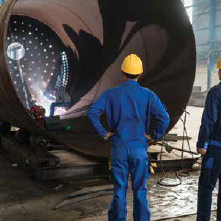Welding Inspection Racine: Ensuring Precision and Reliability in Every Weld
Welding Inspection Racine: Ensuring Precision and Reliability in Every Weld
Blog Article
Cutting-edge Approaches to Fillet Weld Evaluation and Testing: Enhancing Weld High Quality and Compliance Specifications
In the world of welding, the quality and honesty of fillet welds play an essential function in guaranteeing the architectural strength and reliability of numerous industrial components. With the consistent drive for enhanced efficiency and compliance with stringent requirements, the expedition of innovative methods to fillet weld evaluation and screening has come to be critical.
Advanced Non-Destructive Testing Approaches
Using state-of-the-art modern technologies, advanced non-destructive screening methods play a vital role in making certain the integrity and high quality of fillet welds. These methods, such as phased selection ultrasonic testing (PAUT) and magnetic bit screening (MPT), offer in-depth understandings into the weld's interior framework without causing any type of damages to the product. PAUT, as an example, uses numerous ultrasonic elements to check the weld from numerous angles, providing an extensive visualization of possible defects like lack of combination or splits.
In A Similar Way, MPT is effective in finding surface-breaking issues by applying an electromagnetic field and iron bits to the weld location. This approach is particularly helpful for determining stoppages that may jeopardize the weld's stamina. By using these advanced non-destructive testing techniques, weld inspectors can precisely analyze the top quality of fillet welds, ensuring compliance with industry standards and policies. The capability to discover problems early on not only enhances weld quality but also avoids expensive rework or failures in structural integrity, underlining the importance of these ingenious testing methods in welding evaluations.
Robotics and Automation in Evaluation
The combination of robotics and automation has revolutionized the examination procedure for fillet welds, enhancing performance and precision in quality evaluation. Robotics offer specific control and repeatability in evaluating welds, making sure constant and reliable outcomes. Automated systems can be configured to follow details evaluation courses, making sure comprehensive coverage of welds and minimizing the threat of human error.
Robot evaluation systems furnished with advanced sensing units can detect and determine weld features with high precision, giving in-depth data for analysis. These systems can recognize problems such as splits, lack of combination, and porosity, making it possible for prompt corrective activities to be taken. In addition, robotics and automation permit real-time data collection and evaluation, supplying immediate comments to drivers and helping with quick decision-making procedures.
Furthermore, the use of robotics and automation in fillet weld assessment boosts total productivity by decreasing assessment times and raising inspection throughput. By streamlining the evaluation process, makers can make certain weld top quality and conformity criteria are met efficiently, ultimately leading to cost savings and enhanced product quality.
Utilizing Expert System for Analysis
Expert system plays a pivotal role in enhancing the efficiency and precision of analysis in fillet weld inspection processes. By harnessing the power of AI, inspectors can streamline the evaluation of weld quality and conformity criteria, causing a lot more exact and trusted outcomes. AI algorithms can rapidly refine substantial quantities of data from weld inspections, spotting defects or inconsistencies that might be testing to relate to the naked eye. This advanced technology makes it possible for real-time tracking of weld high quality, permitting prompt restorative actions to be taken if any image source kind of issues are detected.
Additionally, AI systems can learn from past examination data, continuously boosting their ability to determine possible defects and variances in fillet welds. This flexible learning capability improves the total quality control process, decreasing the probability of human mistake and ensuring that welds meet the needed criteria. By incorporating artificial intelligence into fillet weld analysis, markets can attain greater degrees of efficiency, consistency, and compliance in their assessment methods.
Portable Tools for On-Site Evaluation
 Enhancing field evaluation effectiveness, the fostering of mobile devices revolutionizes on-site evaluation procedures for fillet welds. These devices use adaptability and convenience, allowing assessors to perform thorough examinations in various places, including remote or tough settings. Mobile devices such as ultrasonic screening gadgets, magnetic fragment examination equipment, and electronic radiography systems provide real-time data and high-resolution imaging capabilities, enabling quick decision-making and instant comments on weld top quality.
Enhancing field evaluation effectiveness, the fostering of mobile devices revolutionizes on-site evaluation procedures for fillet welds. These devices use adaptability and convenience, allowing assessors to perform thorough examinations in various places, including remote or tough settings. Mobile devices such as ultrasonic screening gadgets, magnetic fragment examination equipment, and electronic radiography systems provide real-time data and high-resolution imaging capabilities, enabling quick decision-making and instant comments on weld top quality.One considerable benefit of portable tools is their capacity to simplify inspection treatments, lowering downtime and improving general productivity. Inspectors can conveniently move these devices to different job websites, removing the requirement for carrying heavy equipment or parts to off-site facilities. Additionally, the transportability of these devices promotes cost-effectiveness by minimizing transport costs and accelerating examination timelines.
Additionally, making use of mobile devices for on-site inspection advertises positive quality assurance procedures, as examiners can promptly determine and address any kind directory of prospective welding issues or inconsistencies. By incorporating these cutting-edge innovations right into on-site evaluation techniques, welding experts can ensure compliance with sector requirements and boost weld high quality, inevitably resulting in boosted structural honesty and safety in different welding applications.
Integration of Information Monitoring Systems
Having actually optimized on-site assessment procedures through the usage of mobile tools, the next phase entails the seamless combination of information management systems to even more boost performance and data analysis abilities in fillet weld examination and testing. Welding Inspection Racine. By integrating information monitoring systems into the evaluation process, companies can simplify data collection, storage, and analysis. This combination enables for real-time surveillance of weld top quality, immediate recognition of issues, and punctual decision-making to rectify any issues that may occur throughout the assessment procedure
Information monitoring systems play a crucial role in centralizing evaluation data, facilitating easy access for authorized workers, and making sure information honesty and protection. Via the assimilation of these systems, assessors can create detailed records, track historical data for trend analysis, and boost total procedure performance. Moreover, the combination of data management systems enables seamless interaction in between different stakeholders involved in the inspection procedure, promoting partnership and enhancing total top quality control procedures. Ultimately, the assimilation of data management systems offers to elevate the criteria of fillet weld evaluation and screening, making sure compliance with market policies and boosting weld high quality.
Conclusion
In verdict, cutting-edge methods to fillet weld inspection and screening have considerably improved weld quality and conformity criteria. Advanced non-destructive testing techniques, robotics, automation, expert system, mobile devices, and information monitoring systems have changed the means weld inspections are performed. By utilizing these technologies, markets can make certain that welds meet the required high quality requirements and policies, inevitably boosting total efficiency and safety in welding processes.

By employing these advanced non-destructive screening strategies, weld assessors can properly analyze the top quality of fillet welds, making certain conformity with market requirements and policies. Portable tools such as ultrasonic screening tools, magnetic bit assessment devices, and digital radiography systems provide real-time information and high-resolution imaging capacities, making it possible for quick decision-making and immediate feedback on weld top quality.
Having actually maximized on-site examination procedures through the utilization of mobile devices, the next stage entails the seamless integration of information administration systems to even more enhance performance and data analysis capacities in fillet weld evaluation and testing (Welding Inspection Racine). Inevitably, the combination of data monitoring systems serves to boost the requirements try this web-site of fillet weld evaluation and screening, guaranteeing compliance with market policies and boosting weld high quality
 In final thought, innovative strategies to fillet weld assessment and testing have actually substantially enhanced weld top quality and conformity standards.
In final thought, innovative strategies to fillet weld assessment and testing have actually substantially enhanced weld top quality and conformity standards.Report this page